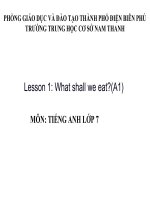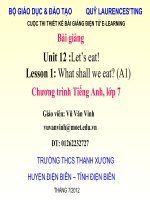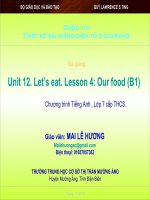Giáo án Tiếng Anh 7 unit 12: Let’s eat
Bạn đang xem bản rút gọn của tài liệu. Xem và tải ngay bản đầy đủ của tài liệu tại đây (121.55 KB, 23 trang )
Giáo án Tiếng anh 7.
UNIT 12: LET’S EAT !
A: What shall we eat?
Lesson 1/73: A1
A. Aim.
By the end of the lesson Ss will be able to practice reading a text to
understand in details and practice Food vocabulary.
*/ Teaching aids: T’s and Ss’ books, tape, cassette, Pictures 14+15+16.
B. Content.
1. Warmer: Kim’s game
- T uses pictures 13+14+15 and hangs them on the board.
- T divides the class into 3 groups.
- Ss observe them in 2 minutes then T puts off the pictures.
- Ss in three groups come to the board, remember and write the food they saw
on the pictures.
- T’s correction.
=> T leads in the lesson: These are some food that we have already learnt.
Today, we are going to learn some more new food and fruits.
2. Pre-teach vocabulary.
- pork (n) : thit lợn (picture)
- spinach (n) : rau mâm xôi, chân vịt (trans.)
- cucumber (n) : da chuột ( realia)
- papaya (n) : quả đu đủ ( realia)
- pineapple (n) : quả dứa (picture)
- durian (n) : quả sầu riêng (trans)
- smell (v) : ngửi (mime)
*/ Checking vocab. R.O.R
MARKET
3. Pre- reading.
a) Set the scene.
T: These are Hoa and her aunt. They are going to the market to buy some food.
Let’s guess what food they bought.
b) Open- prediction.
Food Hoa and her aunt bought
◊ Have Ss look at the three pictures 14+15+16 and guess
◊ T gets Ss’ prediction and takes notes.
4. While-reading.
a) Checking prediction.
- Have Ss read the text in silence and check their prediction.
- Ss share and compare.
- T gets Ss’ answers and corrects if necessary.
KEY:
Hoa and her aunt bought some beef, spinach, cucumber, oranges.
b) Practice reading.
- Have Ss listen to the tape twice.(dialogue by dialogue)
- T calls some pairs to practice reading before class -> T corrects their
pronunciation if necessary.
c) Comprehension questions.
- T gives out some questions, Ss work in groups to read the dialogues again and
prepare for the answers.
GAME: Lucky Numbers.
1
6
2
7
3
8
4
9
5
10
Questions:
1. What did Hoa and her aunt buy at the market?
2. LN
3. Does Hoa like pork?
4. Does Hoa’s aunt like pork? Which sentence tells you about this?
5. What are Hoa’s favorite vegetables?
6. LN
7. Does Hoa’s aunt like peas and carrots? How do you know ?
8. Why did they buy spinach and cucumbers for dinner?
9. Why didn’t they buy papaya, pineapple and bananas?
10.LN
KEY:
1. They bought some beef, spinach, cucumber, oranges.
3. No, she doesn’t. “ I don’t like pork.”
4. No, she doesn’t. “Neither do I”
5. Hoa’s favorite vegetables are peas and carrots.” I’d like some peas and I’d
like some carrots, too”
7. No, she doesn’t. “ I hate carrots and I don’t like peas, either.”
8. They bought spinach and cucumbers because they like them. “ I like spinach
and cucumbers. / So do I.”
9. Because they aren’t ripe. “ Papaya and pineapple aren’t ripe. Neither are the
bananas.”
d) New function:
- T uses the answers above to present the new language items
- T asks Ss to translate some sentences that T takes notes into Vietnamese.
- T emphasizes some important words.
+ too
+ so
Dùng để diễn đạt sự đồng ý với ý kiến nói trớc.
+ either
+ neither
- T asks Ss to study more about these words at home. They will be practiced
more in next lesson.
5. Post-reading.
*/ Speaking: Chain game
- Have Ss look at the three pictures 14+15+16 and talk about the food they like or
dislike.
(Ss can talk about other food beyond the pictures)
Example Exchange:
S1: I like fish.
S2: I like fish and I like pork.
S3: I like fish,pork,....
◊ Ss work in groups of 4-> 6.
◊ T calls some groups to practice before class.
6. Homework.
- Learn new vocabulary by heart.
- Practice reading the dialogues.
- Make a list if the food you like or dislike.
- Do exercise 1(P.74 – W.B)
UNIT 12: LET’S EAT!
A.What shall we eat?
Lesson 2/ 74: A2( too, either)
A. Aim.
By the end of the lesson Ss will be able to understand the usage of “too, either”
then practice structures “ I like...,too/ I don’t like..., either” to express preferences.
*/ Teaching aids: T’s and Ss’ books, posters.
B. Content.
1. Warmer: Brainstorm.
food
fruit
vegetable
s
◊ T divides class into 3 groups with 3 color chalks.
◊ Ss come to the board and list the food, fruit and vegetables that they haver
learnt.
*/ Making a list.
- T asks Ss to take out their draft and make notes about the food, fruit and
vegetables they like or dislike.
Like
Dislike
....
....
( When Ss finish their work, T asks Ss to put this list off to use later)
=> T leads in the lesson: Look at the list of food, fruit and vegetables again. Today
we are going to learn how to speak about the food, fruit and vegetables we like or
dislike.
2. Presentation.
They are at the market.
They want to buy some food,
fruit and vegetables.
T: Do you remember about Hoa and her aunt?
Where are they?
What do they want to buy?
Ss answer.
=> T leads in: Let’s read after me the dialogue between them.
*/ Dialogue build: (on a poster – with answer key)
Hoa’s aunt: What vegetables do you like for dinner, Hoa?
Hoa
: I like cucumbers. Do you like them,too?
Hoa’s aunt: Yes, I like them, too.
Hoa
: OK. Let’s get some.
Hoa’s aunt: What about meat? I don’t like pork. Do you like it, Hoa?
Hoa
: No, I don’t like it, either.
Hoa’s aunt: Let’s have some beef.
- Steps: T reads the dialogue – Ss listen and repeat
Ss read the dialogue in chorus -> individually->Ss come to the board and
complete the dialogue -> T’s corrections.
◊ T gives out the model sentences:
A: I like cucumbers.
B: I like them, too./ I do, too.
A: I don’t like pork.
B: I don’t like it, either./ I don’t, either.
◊ T asks Ss to base on the examples and give out the function of “ too, either”
*/ Concept check:
• Form: Where does “too/ either” situated?
( đứng ở vị trí cuối câu, trớc đó có dấu phẩy)
• Use: What is “too/ either” used for?
( dùng để diễn đạt sự đồng ý; dùng “too” khi đồng ý với ý kiến
khẳng định; dùng “either” khi đồng ý với ý kiến phủ định)
• Meaning: ( T asks Ss to translate the Model sentences into
Vietnamese)
3. Practice.
*/ Word Cues Drill: ( Controlled- practice)
◊ T gives out some word cues
chicken
carrots
peas
bananas
fish
pineapples
◊ Steps: Have Ss run through the pictures/ words.
T models then writes the model sentences on the board->T makes models
with a student->T calls 2 Ss to make a dialogue with a picture.( Openpair)
-> Ss practice in pairs – T monitors. (closed-pairs)
Example Exchange:
S1: I like bananas. Do you like them?
S2: Yes, I like them, too./ Yes, I do, too.
S1: I don’t like fish. Do you like it?
S2: No, I don’t like them, either./ No, I don’t, either.
*/ Production ( Free- practice)
- Have Ss use the list of food they made about food they like or dislike ( at the
beginning of the lesson) to make similar dialogues as above. ( Ss have to take notes
in order to report afterwards)
- Group-work (4-> 6 Ss (in 2 desks))
*/ Report:
- T asks Some Ss to report about the food that their partners like or dislike.
Ex: Lan likes pork, spinach...; but she doesn’t like beef, peas...
5. Homework.
- Further practice with “ too/ either” at home. - Do exercise 2 (P.74 – W.B)
Unit 12: LET’S EAT
A: WHAT SHALL WE EAT ?
Lesson 4/76: A3+4
A. Aim.
By the end of the lesson Ss will be able to practice reading a text to understand
how to make a meal.
*/ Teaching aids: T’s and Ss’ books, posters.
B. Content.
1. Warmer. Shark attack
C O O K I N G
2. Pre-teach vocabulary.
- slice (v) : thái mỏng, cắt mỏng
(translation)
- boil (v) : luộc, nấu
(translation)
- heat (v) : làm nóng
(translation)
- stir-fry (v) : xào
(translation)
- add (v) : cho thêm
(translation)
- dish (n) : món ăn
(translation)
*/ Checking vocab. R.O.R
3. Pre-reading.
*/ Ordering.
- T elicits: Hoa and her aunt will make a meal with beef, cucumber, spinach and
rice.
Can you guess the order they make the meal.
- T gives out the statements on a poster.
a) First, she sliced the beef.
b) Then, she cooked some rice and boiled some spinach.
c) Hoa’s aunt cooked dinner.
d) Next, she sliced some green peppers and onions.
e) And then she set the table and her family sat down to eat.
f) After that, ahe stir-fried the beef and vegetables.
g) Finally, she sliced the cucumbers and made cucumber salad
- Have Ss read the statements and guess the order of them.
4. While-reading.
*/ Checking prediction.
- Have Ss read the text in sliently and check their prediction.
- T gets Ss’ answers and corrects if necessary.
KEY:
c) – a) – d) – b) – f) – g) – e)
*/ Matching.
- T draws a bowl, a plate, a glass, a spoon and chopsticks ans asks Ss to guess the
meanings of them (maybe match with their meanings)
*/ Reading comprehension.
- Have Ss read the text again, in pairs, discuss and complete the Menu.
- Ss share and compare with other pairs.
- T gets Ss’ answer and corrects if necessary.
KEY:
MENU
Boiled spinach
Stir-fried beef with green peppers and onions.
Cucumber salad with onions.
Rice
- Have Ss read the text again and add the missing verbs to complete Hoa’s aunt
recipe.
KEY:
(1) Slice
(2) Slice
(3) Heat
(5) Add
(6) Cook
(7) Add
(4) Stir-fry
- Tell Ss match the instructions to the pictures.
KEY:
(1) – c
(2) – f
(3) – a
(4) – d
(5) – b
(6) – e
(7) –
g
5. Post-reading.(A4 –P.118)
- Tell Ss to think about the food they ate, the drink they drank yesterday and make
a list.
Ex: For breakfast, I ate rice and chicken...
I drank orange juice....
For lunch, I ate....
I drank....
For dinner, I ate...
I drank....
- Have Ss work in pairs, ask their partners what they ate and drank yesterday.
Ex:
S1: What did you eat for breakfast yesterday?
S2: I ate...
S1: What did you drink for breakfast yesterday?
S2: I drank...
- T calls some pairs to practice before class.
6. Homework.
- Learn new vocab. by heart.
- Practice reading.
- Do exercise 5(P.76 - W.B)
Unit 12: LET’S EAT
B: OUR FOOD
Lesson 5/77: B1+4
A. Aim.
By the end of the lesson Ss will be able to practice listening for specific
information to understand why Ba had to go to the doctorr’s and further practice in
Food vocabulary.
*/ Teaching aids: T’s and Ss’ books, posters, tape, cassette.
B. Content.
1. Warmer. Jumbled words
sifh
awert
= fish
= water
snoodel
eicr
2. Pre-teach vocabulary.
- dirt (n) : bẩn
- dirty (adj) :
- probably( adj) : có lẽ
- wash(v) : giặt, rửa
*/ Checking vocab. Slap the board
3. Pre-litening.
*/ T/F Statements. (on aposter)
1. Ba had a headache.
2. Ha was at the doctor’s.
= noodles
= rice
jucei
= juice
3. He ate spinach, but his parents didn’t.
4. His Mum washed the spinach.
5. Vegetables often have dirt on them.
6. That dirt can’t make him sick.
- Have SS read the statements and guess if they are T/F.
4. While-listening.
*/ Checking prediction.
- Have ss listen to the tape/ T’s reading (twice).
- Ss listen and check their prediction.
- Ss share and compare with their partners.
- T gets Ss’ answers and corrects if necessary.
KEY: 1 –F
;2 – T
;3–T
4–F
;5 – T
;6 - F
*/ Reading comprehension.
- Have Ss open their book (P.119), raed the dialogue to understand ytthe details
and answer the questions.
Questions:
1. What did Ba eat last night?
2. Who washed the spinach?
3. Why did Ba go to the doctor?
4. What made him sick?
KEY:
1. He ate fish, rice, soup and spinach.
2. Ba washed the spinach.
3. Because he had a stomachach.
4. The dirt on the vegetables.
*/ Gap-fill:
- Ss work in pairs, read the dialogue again, discuss and complete the story.(B1–
P.119)
- T gets Ss’ answers and corrects if necessary.
KEY:
1. doctor
;2. sick
7. more carefully
;3. asked
;4. had
;8. vegetables
;5. spinach
;9. make
;10. she
;6. wash
;11.
medicine
5. Post-listening.(B4 – P.121)
- Have Ss run through the pictures.
- Tell Ss to guess what Lan, Ba, Nga and Hoa had for their lunch.
- Have Ss listen to the tape/ T’s reading twice.
- Ss listen and check their prediction.
- T gets Ss’ answers and corrects if necessary.
KEY:
Lan: b, d, f, g
Ba: c, a, e, h
Nga: a, d, g
Hoa: b, e, g
*/ Tape transcript:
For her lunch, Lan had beef with noodles and vegetables. She had juice, too. Ba
chose fish and rice and some friut. He drank some water. Nga ate rice and
vegetables and drank juice. Hoa had noodles and some fruit. She had juice, too.
6. Homework.
- Learn new vocab. by heart.
- Do exercises
(W.B)
Unit 12: LET’S EAT
B: OUR FOOD
Lesson 6/78: B2
A. Aim.
By the end of the lesson Ss will be able to practice reading a text about a balance
diet and further practice in Indefinite quantifiers “a little, too much, plenty of, lots
of”
*/ Teaching aids: T’s and Ss’ books, posters.
B. Content.
1. Warmer. Hang man
A
B A L A N C E
D I E T
2. Pre-teach vocabulary.
- moderate (adj) : cân đối
- affect (v) : ảnh hưởng
- energy (n) : năng lượng
- dairy product (n) : sản phẩm từ sữa
- lifestyle (n) : lối sống
*/ Checking vocab. Slap the board
3. Pre- reading.
- T asks:
? What is your favorite food?
? What do you always have for your breakfast/ lunch/ dinner?
? Do you think your diet is balance?
- Ss answer.
*/ T/F Statements. (on a poster)
1. Eat alot of meal.
2. Eat a little fruit, vegetables.
3. Eat a moderate amount of sugar.
4. Eat a little fatty food.
5. eat plenty of the food you like.
- Have Ss read the statements and guess beforeb reading.
4. While –reading.
a) Checking prediction.
- Have Ss read the text silently and check their prediction.
- Ss share and compare.
- T gets Ss’ answers and corrects if necessary.
KEY:
(1) F
; (2) F
; (3) T
; (4) T
; (5) F
b) Comprehension Questions.
- Have ss run through the questions (P.120)
- Ss work in pairs, read the text again and answer the questions.
- T calls some Ss to give their answers -> T’s corrections.
KEY:
a) Sugar adds tastes to food and it gives you energy.
b) No, it isn’t. A balance diet is not enough, all people need to exercise to keep
a healthy life.
5. Post-reading.
*/ Speaking.
- Have Ss work in groups of 4-> 6. Discuss about the question: Do you think your
diet is balance? Why/ Why not?
- T goes round the class and gives help if necessary.
- T calls some groups to practice before class.
*/ Matching.
- Have Ss read the table and match what they should/ shouldn’t do.
a lot of
should
a little
too much
Shouldn’t
plenty of
sugar
fatty food
meat
fruit
coffee
deep- fried food
vegetables
eggs
- Ss do matching then say what food they should/ shouldn’t eat. Why/ why not?
- T calls some Ss to speak loud.
6. Homework.
- Learn new vocab. by heart.
- Practice reading.
- Do exercises
(W.B)
Period 79th: LANGUAGE FOCUS
A. Aim.
By the end of the lesson Ss will be able to Hve further practice in Past Simple
tense, Indefinite quatifiers, “too & either; so & neither” and Imperatives. (From
Unit 9-> Unit 12)
*/ Teaching aids: T’s and Ss’ books, picture N019, cues.
B. Content.
*/ Warmer + Revision.
T: What is the date today?
S: Today is Monday.
T: What was the date yesterday?
S: Yesterday was Sunday.
T: Did you go to school yesterday?
S: No, I didn’t.
T: What did you do yesterday?
S: (answer)
=> ? What tense do we use in these sentences? ( Past Simple Tense)
I. Revision.
1. Past Simple Tense.
- Ask Ss te retell the formation, usage of Simple Past Tense from the examples.
• Form: ( with ordinary verbs)
(+) S + V(past)
(-) S + did + not + V(bare)
(?) Did + S + V(bare) ...?
Yes, S + did.
No, S + didn’t.
• Use: nói về hành động, sự việc xảy ra trong và kết thúc hoàn toàn
trong quá khứ.
- T notes Ss about the form of regular and irregular verbs.
*/ Practice: Mapped Dialogue.
2. Indefinite Quantifiers.
*/ Matching. (on a poster)
a little
a few
a lot of/ lots of
::: rice
too much
::::::
::::::
water
:::::: rice
- T asks Ss to retell the usage of “ a little, a few, a lot of/ lots of, too much”
+ a little: uncountable noun.
+ a few : countable plural noun.
+ a lots of/ lots of : uncountable noun and countable plural noun.
+ too much : uncountable noun.
*/ Practice : Gap-fill (Ex.2 - P. 124)
3. So, neither, too, either.
- T leads in: Tell me what food you like and don’t like.
- Ss answer then T asks other Ss to express their agreement, using “so, neither, too,
either ”
Ex:
S1: I like chicken.
S2: I like it , too/ I do, too./ So do I.
S1: I don’t like fish.
S2: I don’t like it, either./ I don’t, either./ Neither do I.
- T asks Ss to retell the usage of “so, neither, too, either ”
• Use: dùng để nhấn mạnh sự đồng tình ; “so, too” dùng trong câu đồng
tình khẳng định, “ either, neither ” dùng trong câu đồng tình phủ định.
“ so,neither ” đứng ở đầu câu, “ too, either ” đứng ở cuối câu.
*/ Practice: Game: Noughts and Crosses
4. Imperatives.
- T leads in: Open your book at page 127, please.
- Ss open their books.
- T asks Ss what kind of sentence she have said.
=> Imperative.
- Ask Ss to give their understanding about Imperatives.
• Use: câu mệnh lệnh dùng để đưa ra mệnh lệnh, chỉ ra phương hướng
hay đưa ra lời khuyên.
• Note: (You) close the door (, please.)
*/ Practice: Gap-fill.
II. Practice.
1. Mapped – dialogue.
- Have Ss play in 2 teams. (A/B)
A
B
....do...homework last night?
Yes,...
...have dinner at home?
No,....have ....restaurant. What about you?
....go to school yesterday?
No,... go to the movies.
....play soccer yesterday
Yes,...
- Have Ss in 2 teams make questions and answers, if it’s right, this team will get 1
mark and converse.
2. Game: Noughts and Crosses.
- T uses picture N019 as cue.
mango
corn
fish
V
V
X
bananas
spinach
chicken
X
X
X
papaya
X
potatoes X
beef
V
- Have Ss play in 2 groups (A/B)
Example Exchange:
S1: I like mango.
S2: I do, too./ So do I.
S1: I don’t like fish.
S2: I don’t , either./ Neither do I.
- Tell Ss to listen to their friends’ answer, try not to use the similar answer in
a group.
- T monitors and gives help if necessary.
3. Gap-fill:
*/ Ex. 2:
- Have Ss work in pairs, discuss and complete the dialogues.
KEY:
b) A. a little/ a lot
only a little
B. a lot of
C. too much
D. a little
*/ Ex. 5:
- Have Ss work in pair, look at the pictures and fill in the missing verbs from the
box.
KEY:
b) Wash
c) Slice
d) Mix
e) Add
f) Stir
g) Wait
III. Homework.
- Redo exercises on notebook.
- Prepare well for the test ( Revise from Unit 9 -> Unit 12)









